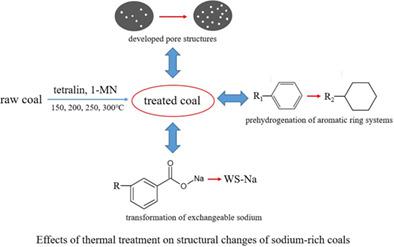当前位置:
X-MOL 学术
›
Int. J. Energy Res.
›
论文详情
Our official English website, www.x-mol.net, welcomes your
feedback! (Note: you will need to create a separate account there.)
Structural changes of Zhundong coal matrix induced by thermal treatment and its effects on oil yield in direct coal liquefaction
International Journal of Energy Research ( IF 4.3 ) Pub Date : 2021-09-14 , DOI: 10.1002/er.7261 Shichao Li 1 , Lu Han 2 , Xiao Li 1, 2
International Journal of Energy Research ( IF 4.3 ) Pub Date : 2021-09-14 , DOI: 10.1002/er.7261 Shichao Li 1 , Lu Han 2 , Xiao Li 1, 2
Affiliation

|
Sodium-rich coals are suitable raw materials for direct coal liquefaction (DCL). However, sodium species in coals, especially exchangeable ones, can significantly reduce oil yield. In this work, to increase oil yield in direct liquefaction of sodium-rich coals, a feasible method using organic solvents to pretreat sodium-rich coals is proposed. Initially, sodium-rich coal was thermally treated with tetralin or 1-methylnaphtalene. Then, raw coal and all the treated coals were liquefied under the same conditions to evaluate the effects of thermal treatment on structural changes of coal molecules and oil yield. The results show that surface areas of the treated coals increased to 7.86 m2/g at most, which was favorable for combination between hydrogen and coal molecules during the DCL process. More importantly, the content of hydrogen in the treated coals was 0.95 wt% higher than that of raw coal on average, suggesting that treated coals could be later liquefied at mild conditions. Raman spectra demonstrated that during thermal treatment with tetralin, small aromatic ring systems in raw coal were prehydrogenated and transformed into nonaromatic systems. The pre-hydrogenation of the coal matrix definitely contributes to the increase in oil yield. In view of sodium species distribution in the treated coals, it is proved that tetralin can promote the transformation of exchangeable sodium species into other chemical forms more easily than 1-methylnaphtalene, which implies that tetralin has more positive effects on the increase of oil yield. Compared with that of raw coal, oil yields in direct liquefaction of the samples treated by tetralin increase by 14.0 to 15.1 wt% (daf).
中文翻译:

热处理诱导准东煤基质结构变化及其对煤直接液化产油率的影响
富钠煤是煤直接液化(DCL)的合适原料。然而,煤中的钠物质,尤其是可交换的钠物质,会显着降低石油产量。在这项工作中,为了提高富钠煤直接液化的石油产量,提出了一种使用有机溶剂预处理富钠煤的可行方法。最初,富钠煤用四氢化萘或 1-甲基萘进行热处理。然后,将原煤和所有处理后的煤在相同条件下液化,以评估热处理对煤分子结构变化和产油率的影响。结果表明,处理后煤的表面积增加到7.86 m 2/g 最大,有利于 DCL 过程中氢气与煤分子的结合。更重要的是,处理后的煤中的氢含量平均比原煤高 0.95 wt%,这表明处理后的煤可以在温和的条件下稍后液化。拉曼光谱表明,在用四氢化萘热处理期间,原煤中的小芳环系统被预氢化并转化为非芳环系统。煤基质的预加氢肯定有助于提高石油产量。从处理煤中钠的分布来看,证明四氢化萘比1-甲基萘更容易促进可交换钠向其他化学形态的转化,这意味着四氢化萘对提高石油产量有更积极的影响。与原煤相比,经四氢化萘处理的样品直接液化的产油率提高了 14.0 至 15.1 wt% (daf)。
更新日期:2021-09-14
中文翻译:

热处理诱导准东煤基质结构变化及其对煤直接液化产油率的影响
富钠煤是煤直接液化(DCL)的合适原料。然而,煤中的钠物质,尤其是可交换的钠物质,会显着降低石油产量。在这项工作中,为了提高富钠煤直接液化的石油产量,提出了一种使用有机溶剂预处理富钠煤的可行方法。最初,富钠煤用四氢化萘或 1-甲基萘进行热处理。然后,将原煤和所有处理后的煤在相同条件下液化,以评估热处理对煤分子结构变化和产油率的影响。结果表明,处理后煤的表面积增加到7.86 m 2/g 最大,有利于 DCL 过程中氢气与煤分子的结合。更重要的是,处理后的煤中的氢含量平均比原煤高 0.95 wt%,这表明处理后的煤可以在温和的条件下稍后液化。拉曼光谱表明,在用四氢化萘热处理期间,原煤中的小芳环系统被预氢化并转化为非芳环系统。煤基质的预加氢肯定有助于提高石油产量。从处理煤中钠的分布来看,证明四氢化萘比1-甲基萘更容易促进可交换钠向其他化学形态的转化,这意味着四氢化萘对提高石油产量有更积极的影响。与原煤相比,经四氢化萘处理的样品直接液化的产油率提高了 14.0 至 15.1 wt% (daf)。











































 京公网安备 11010802027423号
京公网安备 11010802027423号